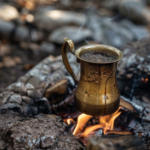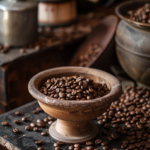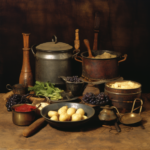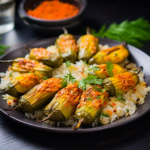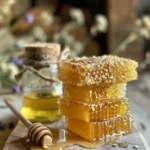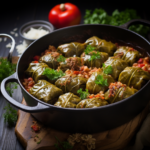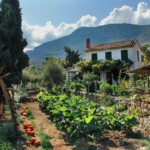Baklava is a beloved Greek dessert, layered with crispy phyllo dough, rich walnuts, and sweet honey. This recipe will guide you through creating a classic version that captures the essence of traditional Greek baklava.
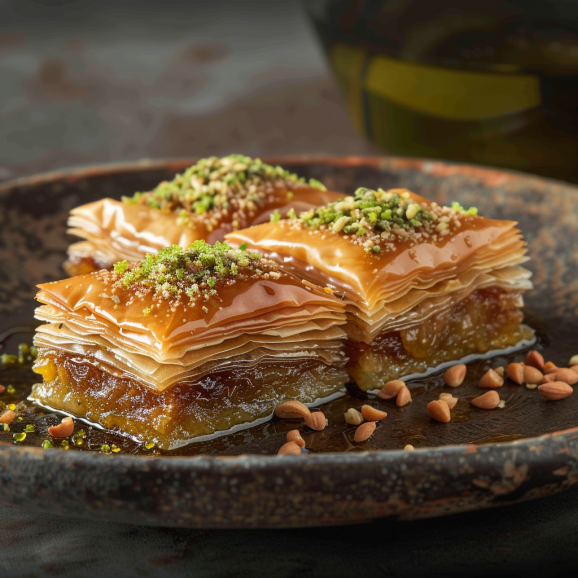
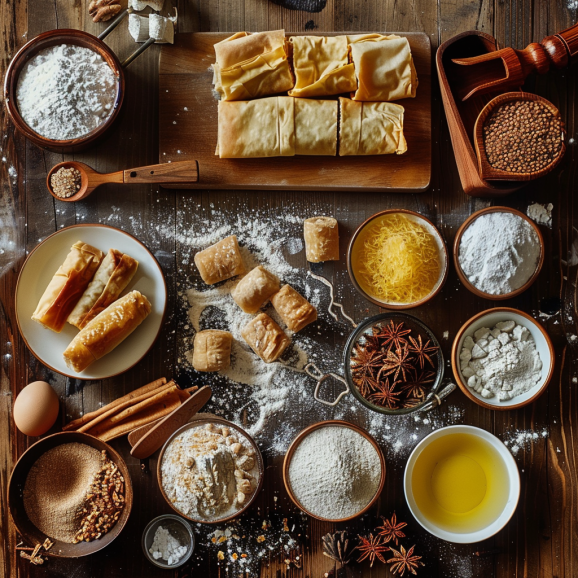
Ingredients:
- Phyllo Dough: 1 package (about 16 ounces), thawed
- Walnuts: 2 cups, finely chopped
- Granulated Sugar: 1/4 cup
- Ground Cinnamon: 2 teaspoons
- Unsalted Butter: 1 cup (2 sticks), melted
- Honey Syrup:
- Honey: 1 cup
- Water: 1/2 cup
- Granulated Sugar: 1/2 cup
- Lemon Juice: 2 tablespoons
- Cinnamon Stick: 1 (optional)
Instructions:
- Prepare the Nut Mixture:
- In a mixing bowl, combine finely chopped walnuts, 1/4 cup sugar, and 2 teaspoons of ground cinnamon. Mix well to distribute the cinnamon and sugar evenly through the nuts.
- Prepare the Phyllo Dough:
- Carefully unroll the phyllo sheets and cover them with a damp cloth to prevent drying out. Take one sheet and place it on a clean work surface. Brush the sheet lightly with melted butter. Repeat this process, layering another sheet on top, until you have stacked 8 sheets.
- Assemble the Baklava:
- Preheat your oven to 350°F (175°C).
- Spread half of the walnut mixture evenly over the top of the stacked phyllo sheets.
- Layer another 8 sheets of phyllo dough, brushing each with butter as before.
- Spread the remaining walnut mixture over the top.
- Top with the remaining phyllo sheets, continuing to brush each sheet with butter.
- Cut and Bake:
- Using a sharp knife, cut the baklava into diamond or square shapes, making sure to cut all the way through to the bottom layers.
- Bake in the preheated oven for about 50 minutes, or until the baklava is golden and crisp.
- Make the Honey Syrup:
- While the baklava is baking, combine honey, water, sugar, lemon juice, and a cinnamon stick in a saucepan.
- Bring to a boil, then reduce to a simmer and cook for about 10 minutes. Remove from heat and let cool slightly.
- Finish the Baklava:
- Remove the baklava from the oven and immediately pour the slightly cooled syrup over the hot baklava.
- Let the baklava absorb the syrup for several hours or overnight before serving. This ensures the layers stay crisp and fully flavored.
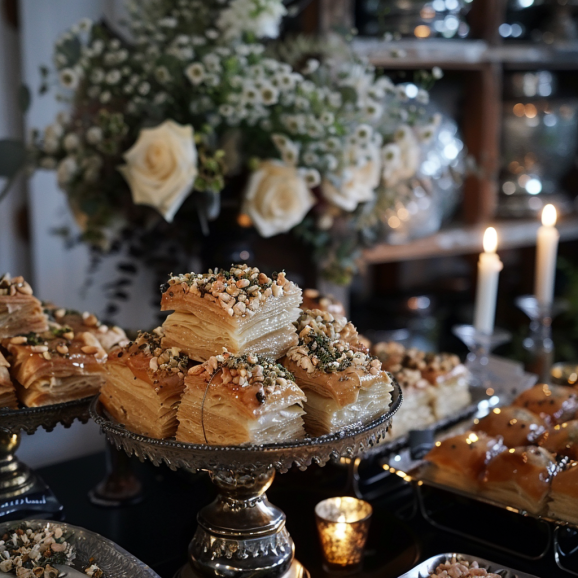
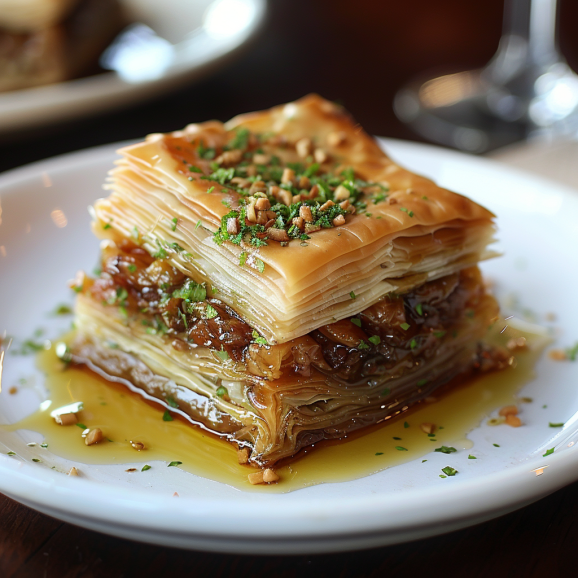
Serving Suggestions:
Serve your baklava at room temperature with a cup of Greek coffee or tea. The combination of sweet, nutty, and buttery flavors with the crisp texture of phyllo makes this dessert a timeless classic in Greek cuisine.
Tips:
- Ensure the phyllo is completely thawed but kept under a damp towel during assembly to prevent it from drying out.
- Be patient when pouring the syrup; it needs time to thoroughly soak into the layers.
This traditional Greek baklava recipe offers a delightful blend of textures and flavors, perfect for any occasion that calls for a sweet, rich dessert.
Pairing with Beverages
To elevate the taste experience, consider pairing it with the right beverage. A traditional Greek coffee, with its strong, rich flavor, complements the sweetness of baklava perfectly. Alternatively, for a more indulgent treat, a dessert wine like Muscat or a late-harvest Riesling provides a lovely contrast to the pastry’s crunch and sweetness.
Health Benefits
Despite its decadence, baklava contains several ingredients that offer health benefits. Nuts like walnuts and pistachios are rich in omega-3 fatty acids, which are beneficial for heart health. The honey in the syrup is a natural antioxidant, providing a healthier alternative to refined sugar.
Customizing Your Baklava
Baklava is highly adaptable. Here are a few ways to customize this dessert to suit your taste or dietary preferences:
- Reduced Sugar: For those looking to decrease the sweetness, reducing the amount of syrup poured over the baklava can make a significant difference without compromising on flavor.
- Spice Infusions: Adding cardamom, rose water, or orange blossom water to the syrup can introduce new, delightful flavors to the traditional recipe.
- Nut Varieties: Mix and match different types of nuts based on availability and preference to create unique taste profiles.
Baklava as a Cultural Ambassador
Not only serves as a delicious dessert but also as a cultural ambassador, bringing people together over shared culinary heritage. It’s commonly featured in festive celebrations and family gatherings, symbolizing hospitality and generosity.
Sustainability and Sourcing Ingredients
When making or purchasing baklava, consider the sustainability of the ingredients. Opting for locally sourced honey and organic nuts can help support sustainable agriculture. Moreover, choosing ethically produced phyllo dough ensures a higher quality of the dessert and supports fair labor practices.
Conclusion
This is a testament to the rich culinary traditions of Greece and its neighboring regions. Whether you’re enjoying a piece at a local café or making it at home, each bite offers a taste of history and craftsmanship. Embracing both traditional methods and modern twists can make baklava an even more enjoyable part of your dessert repertoire.
Through detailed attention to ingredients, preparation, and cultural significance, baklava continues to be a beloved dessert across the globe, cherished for its delightful flavors and textures.
Embark on a gastronomic journey through the heart of Hellenic culinary traditions,
championed by Digital Heroes Caffe and Financial Navagator 360. Your exploration begins at Chef on a Bike, an enclave where cherished Greek culinary customs breathe life into every recipe.
Under the masterful guidance of culinary virtuoso Anna-Maria Barouh, each stir, chop, and simmer transcends mere cooking, evolving into a vibrant learning journey that bridges the age-old culinary wisdom with the vivacious enthusiasm of the new.
Galaktoboureko: Creamy Custard Pie
Custard Encased in Filo Galaktoboureko is a beloved Greek dessert featuring a rich custard encased in crispy filo dough, elegantly bathed in a sweet syrup.
Culinary Complexity The making of Galaktoboureko is complex, as it involves creating a smooth and velvety custard that contrasts perfectly with the crunch of the filo. The result is a dessert that is both luxurious.








